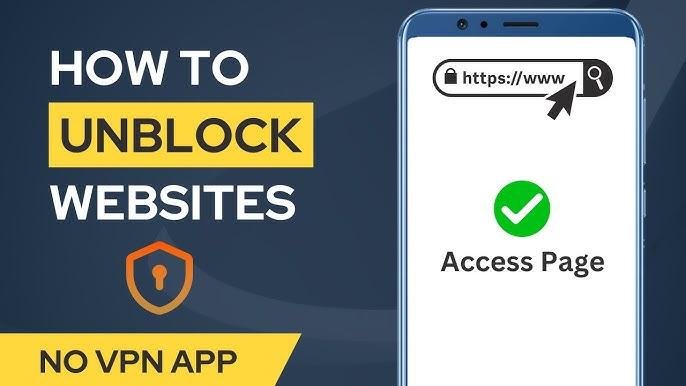Click here to buy secure, speedy, and reliable Web hosting, Cloud hosting, Agency hosting, VPS hosting, Website builder, Business email, Reach email marketing at 20% discount from our Gold Partner Hostinger You can also read 12 Top Reasons to Choose Hostinger’s Best Web Hosting
You try to open a site and the browser gives you a sad error page, or “your organization doesn’t allow this.” That sudden block halts research, work, and simple tasks — and guessing fixes wastes time. The good news: many blocks are local or DNS-level and resolvable in minutes with settings you control. This guide shows how to unblock websites on computers, Chrome, Android and phones — with step-by-step actions, safe non-VPN options, and what to do when the block is large-scale or legal.
3 VPNs That Pass All Tests (2025)
- NordVPN: Zero leaks in tests, RAM-only servers, and Threat Protection to block malware.
- Surfshark: Unlimited devices, Camouflage Mode for bypassing VPN blocks, and CleanWeb ad-blocker.
- ExpressVPN: Trusted Server tech (data wiped on reboot) and consistent streaming access.
Why websites are blocked
Local blocks: hosts file entries, parental controls, antivirus or firewall rules on your device or router.
Browser blocks or permissions: Chrome or extensions can block certain sites or content types.
DNS blocks: ISP or national filters stop domain name resolution; changing DNS may help.
Organization / admin policies: schools or companies can centrally block sites. In managed Chrome environments an admin can block URLs.
How to unblock websites on a computer (Windows / macOS / Linux)
Step 1 — Check the obvious
Open the site in another browser (Edge, Firefox, Safari). If it loads, problem is browser-specific.
Try a different network (mobile hotspot). If the site works, the block is network/ISP/router level.

Step 2 — Browser-level fixes
Clear caches and cookies (browser settings → Privacy & security → Clear browsing data).
Disable extensions temporarily (especially ad-blockers or “site blocker” extensions).
In Chrome, check site permissions: Settings → Privacy and security → Site settings → View permissions and data stored across sites and remove any block for the domain.
Step 3 — Edit hosts file (local block)
Windows: open Notepad as admin, edit
C:\Windows\System32\drivers\etc\hosts— remove lines like127.0.0.1 blockedsite.com.macOS/Linux: edit
/etc/hostswith sudo.
Only remove entries you or an admin placed. Misediting hosts can break access.
Is Using Free Proxy Lists Safe? Understanding the Risks and Safer Alternatives
Step 4 — Change DNS (fast, safe, often works)
Switch from ISP DNS to a public resolver (Cloudflare or Google). Changing DNS can bypass DNS-level blocking in many cases. For Windows or macOS, update network adapter settings to use 1.1.1.1 (Cloudflare) or 8.8.8.8 (Google). Cloudflare publishes setup guides for Windows and Android.
Step 5 — Check firewall / security suites
Temporarily disable firewall/antivirus web-filtering to test (don’t leave it off). Corporate security often blocks sites; contact IT if you’re on a managed machine.
Are Your Devices Truly Invisible? The Surprising Truth Behind Public vs Private IP Addresses
How to unblock websites on Google / Chrome
Consumer Chrome: open Settings → Privacy and security → Security and enable Use secure DNS (choose Cloudflare / Google) — this encrypts DNS and can bypass some ISP DNS blocks. You can also check Site settings for permissions that might deny content. Cloudflare documents how to configure secure DNS options for Chrome.
If Chrome says “Your organization doesn’t allow you to view this site” — that usually means a managed policy set by admins. If this is a work or school device, the proper step is to ask IT; an unmanaged user usually cannot override an admin policy.
Chrome extension tip: If you used blocking extensions (BlockSite, StayFocusd), open the extension menu and remove the domain from the blocklist.
Geolocation Testing Tools for Web Developers: 9 Essential Solutions to Beat Geo-Blocks
How to unblock websites on Android
Quick steps
Use the Chrome app: Menu → Settings → Privacy and security → Site settings → locate domain and change permission or remove data.
Use Private DNS (Android 9+): Settings → Network & internet → Advanced → Private DNS → set hostname to
one.one.one.onefor Cloudflare. Cloudflare offers a full Android setup guide showing this exact path.
If blocked on mobile network only: try switching to Wi-Fi or use mobile data; some mobile ISPs have different blocking policies.
How to Safely Unblock Any Website Without VPN (Works on PC & Mobile)
How to unblock websites on phones (iPhone)
Safari / iOS: Settings → Safari → Clear History and Website Data. For DNS on iOS, go to Wi-Fi → tap the network → Configure DNS → Manual → add
1.1.1.1or8.8.8.8. 7 Best Mobile VPN for iPhone: Secure & Fast VPN AppsIf a profile (MDM) or Screen Time is restricting sites, check Settings → Screen Time → Content & Privacy Restrictions.
How to unblock websites in Pakistan — what to know
Country-level blocking can be implemented in several ways (DNS filtering, IP blocking, SNI filtering). Changing DNS or using secure DNS (DoH/DoT) sometimes works for DNS filters; Cloudflare’s documentation shows how to enable encrypted DNS on clients.
Caution & recommended approach
If a site is officially blocked by the regulator or due to legal orders, bypassing may violate local law. When in doubt, use lawful channels: contact the site owner, check PTA notices, or pursue complaint processes. If you’re a journalist or researcher facing a content access barrier, consider legal counsel or an accredited institution’s IT support.
If the block is accidental (site miscategorization), Cloudflare and other DNS providers provide forms to report misclassification; contacting your ISP or the site owner often resolves it.
How to unblock websites on Chrome (recap & quick commands)
Settings → Privacy and security → Site settings → find domain → allow content.
Settings → Privacy and security → Security → Use secure DNS → select Cloudflare.
How to unblock websites without VPN
If you cannot or prefer not to use a VPN, try these methods (many are instant):
Change DNS to Cloudflare (1.1.1.1) or Google (8.8.8.8) — works for DNS-level filters.
Enable Secure DNS (DoH/DoT) in browser — encrypts DNS requests so ISP DNS can’t be snooped/modified.
Use the Wayback Machine or Google cache for read-only access to content if the live site is blocked.
Use a web proxy or SSH tunnel (advanced) — proxies can fetch the page for you; use trusted services only.
Tor Browser — not a VPN and built for anonymity; can access censored content but has a learning curve and is blocked in some networks or countries.
How to Safely Unblock Any Website Without VPN (Works on PC & Mobile)
Mini case study — DNS fixed a blocked news feed
A small NGO reported a blocked newsfeed on office Wi-Fi. Steps they took:
Verified the feed worked on mobile data.
Changed router DNS to Cloudflare’s
1.1.1.1. The feed returned immediately.Reported the issue to the ISP; ISP corrected an accidental filter shortly after.
Lesson: many blocks stem from DNS and are reversible without VPNs or major rewiring.
Key Takeaways
Start local: check other browsers, networks, and your hosts file before assuming wide censorship.
Changing DNS or enabling secure DNS often unblocks sites quickly and is the least intrusive fix.
Managed devices and org policies are intentionally restrictive; work with IT rather than trying to override admin controls.
In-country censorship requires care: respect local laws and use formal complaint routes when possible.
Non-VPN options (Cloudflare DNS, secure DNS, proxies, Tor) give choices — pick the one that matches your risk and legal context.
FAQs (People Also Ask)
Q: Will changing DNS always unblock a site?
A: No. DNS changes help when the block is DNS-level (name resolution). If the block is IP-based or uses deep packet inspection (SNI/IP filters), DNS swaps may not help.
Q: Can I unblock a site on a work computer?
A: If an admin set a policy, you cannot (and should not) override it. Contact your IT team to request access if it’s work-related.
Q: Is using Tor or a proxy illegal?
A: It depends on local law. In some countries, use of Tor or circumventing blocks can have legal consequences. Always check local regulations and use legal channels when possible.
Q: How do I report a misclassified blocked site?
A: If using a DNS filter like Cloudflare’s family option or a security product, use their misclassification/report form. Also contact your ISP — many blocks are accidental and fixed quickly.
Conclusion
This guide walked you through how to unblock websites on computers, Chrome, Android, and phones—plus country-level notes for Pakistan and non-VPN options. Start with simple checks (browser, hosts file), then try DNS and secure DNS before moving to advanced tools. If you’re on a managed device or the block is regulatory, follow formal channels. Want more tactical step-by-step screenshots or router instructions? Check our tools and privacy roundups.
Sources (official)
Cloudflare — 1.1.1.1 setup and private DNS guidance (Windows, Android, secure DNS). Cloudflare Docs+1
Google Chrome enterprise support — allow/block access and managed policies (explains admin blocks). Google Help
Now loading...






